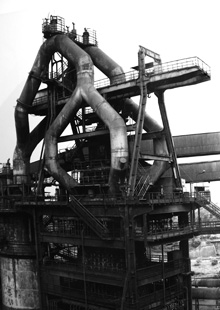General Steel History
Steel is a composition of iron and carbon. It is a material that has been used for thousands of years; however, it hasn’t been until the last century and a half that it has become a readily available material. The complex process of creating steel was far too expensive until Henry Bessemer patented his industry changing Bessemer process.
Steel begins with iron ore. Unfortunately, iron is not found in a pure form and thus must be extracted from ore. To do so, the ore must be smelted, meaning that it is melted to a liquid state and then other elements, mainly carbon, are combined with the molten ore to bond with and extract impurities in the ore. During this process, the iron absorbs a great amount of carbon—too much to create what would be considered steel. Here, the Bessemer process comes into play.
The Bessemer process uses large blast furnaces again to melt the carbon rich iron. Next, air is blasted through the mixture to burn on excess carbon. This is done in a controlled manner until only 0.2 – 1.7 % carbon remains. The presence of carbon in the iron hardens/stiffens the material; however, after a certain point, the mixture becomes brittle and useless for structure. It is this point in history where the steel industry becomes strongly tied with Pittsburgh and the concerns of our project discussed below.
Today the Bessemer process has been replaced by the Linz Donawitz Process (1968). The Linz Donawitz Process blasts pure oxygen through the molten iron rather than air, allowing for a more controlled final composition. Today there are many forms of steel created using the Linz Donawitz Process, below are a few of the most common:
Carbon Steel—90% of all steel, most often used for structural purposes
HSLA—high strength steel created by the addition of small amounts of
manganese
Low Alloy—steel with the addition of manganese, chrome, nickel or other
elements for harder thick steel
Stainless—steel with roughly 10% chromium to resist rust
Tool Steel—steel with a mixture of cobalt for hardening
Steel in Pittsburgh
Pittsburgh located in the Allegheny Mountains has shown significant production of metal goods since 1812 when the area was known for the production of iron and copper goods. The reason for this is that the mountain chain has a fair amount of iron ore especially. It was after the patent of the Bessemer process in 1955 that Pittsburgh made its rise as the steel capital of the country. The Bessemer process revolutionized the steel making process; steel was now affordable for mass production. This break through in the industry combined with the access to iron ore in the Pittsburgh region combined with the transportation opportunities in the region (the converging of the Allegheny, the Ohio and the Monongahela Rivers). Steel plants quickly appeared all along the rivers in the city. The Civil War and the demand for the production of steel war materials continued to fuel the industry in Pittsburgh and after the war, the rise of railroads showed no end to the demand for steel production. As the center of steel, railroads for transportation became increasingly important. In addition to the a long list of advantages for steel production in Pittsburgh, a steady wave of immigrants also found their way to Pittsburgh providing the labor needed to support the steel industry.
Around the late 1800’s Andrew Carnegie took the Pittsburgh steel industry to its peak. His efforts to merge some of the largest steel producers lead to somewhat of a monopoly on steel. In 1901 Carnegie sold his company to US Steel and at its peak around the turn of the century, Pittsburgh produced between 1/3 and ½ of the nation’s steel. Ironically, there were questions about the industry in Pittsburgh during this time as well. At this point, Pittsburgh had exhausted most of its iron ore supply. Most iron ore was arriving in Pittsburgh from Michigan and the rest of the Mid West. Steel plants in the Mid West began to rise and were able to offer lower prices because there were less shipping costs in the production of their steel. Still having the largest portion of steel production in the US, the industries in Pittsburgh were able to pass the Pittsburgh Plus plan in 1907 which created a price floor for steel and allowed the Pittsburgh steel industry remain competitive despite higher transportation costs. In 1924, the Pittsburgh Plus plan was ruled unconstitutional and was banned. It was here that the steel industry in Pittsburgh began to lose grip.
World War II provided another brief spike in steel production for Pittsburgh. Afterward, the industry made a steady decline unable to compete with industry in the West and Mid West. With the decline of the steel industry, Pittsburgh also saw a decline in population: in 1950 the city had 680 000 inhabitants, this figure dropped to 330 000 in 2000.
Pittsburgh after Steel
The steel industry left a permanent mark on Pittsburgh. After production surges in WWII pollution became a major issue in the city. Waste material destroyed the rivers and the industry lined rivers locked the city and its citizens away from the river fronts. In the 50’s the first large efforts to clean the industry were put into effect known as the Renaissance Project. Later in the 70’s a second Renaissance Project focused more on brining the citizens of Pittsburgh back to the river front. Today, we see continued efforts to revitalize the river fronts. Tourism, medical technologies, robotics, bio medical technologies and other high tech industries have replaced the steel industry.




No comments:
Post a Comment